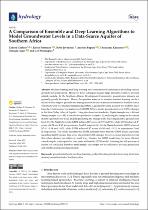| dc.contributor.author | Gaffoor, Zaheed | |
| dc.contributor.author | Pietersen, Kevin | |
| dc.contributor.author | Jovanovic, Nebo | |
| dc.date.accessioned | 2022-08-30T13:00:46Z | |
| dc.date.available | 2022-08-30T13:00:46Z | |
| dc.date.issued | 2022 | |
| dc.identifier.citation | Gaffoor, Z. et al. (2022). A comparison of ensemble and deep learning algorithms to model groundwater levels in a data-scarce aquifer of Southern Africa. Hydrology, 9(7), 25. https://doi.org/10.3390/hydrology9070125 | en_US |
| dc.identifier.issn | 2306-5338 | |
| dc.identifier.uri | https://doi.org/10.3390/hydrology9070125 | |
| dc.identifier.uri | http://hdl.handle.net/10566/7785 | |
| dc.description.abstract | Machine learning and deep learning have demonstrated usefulness in modelling various
groundwater phenomena. However, these techniques require large amounts of data to develop
reliable models. In the Southern African Development Community, groundwater datasets are
generally poorly developed. Hence, the question arises as to whether machine learning can be a
reliable tool to support groundwater management in the data-scarce environments of Southern Africa.
This study tests two machine learning algorithms, a gradient-boosted decision tree (GBDT) and a
long short-term memory neural network (LSTM-NN), to model groundwater level (GWL) changes
in the Shire Valley Alluvial Aquifer. | en_US |
| dc.language.iso | en | en_US |
| dc.publisher | MDPI | en_US |
| dc.subject | Groundwater | en_US |
| dc.subject | Neural networks | en_US |
| dc.subject | Machine learning | en_US |
| dc.subject | South Africa | en_US |
| dc.subject | Earth science | en_US |
| dc.title | A comparison of ensemble and deep learning algorithms to model groundwater levels in a data-scarce aquifer of Southern Africa | en_US |
| dc.type | Article | en_US |

